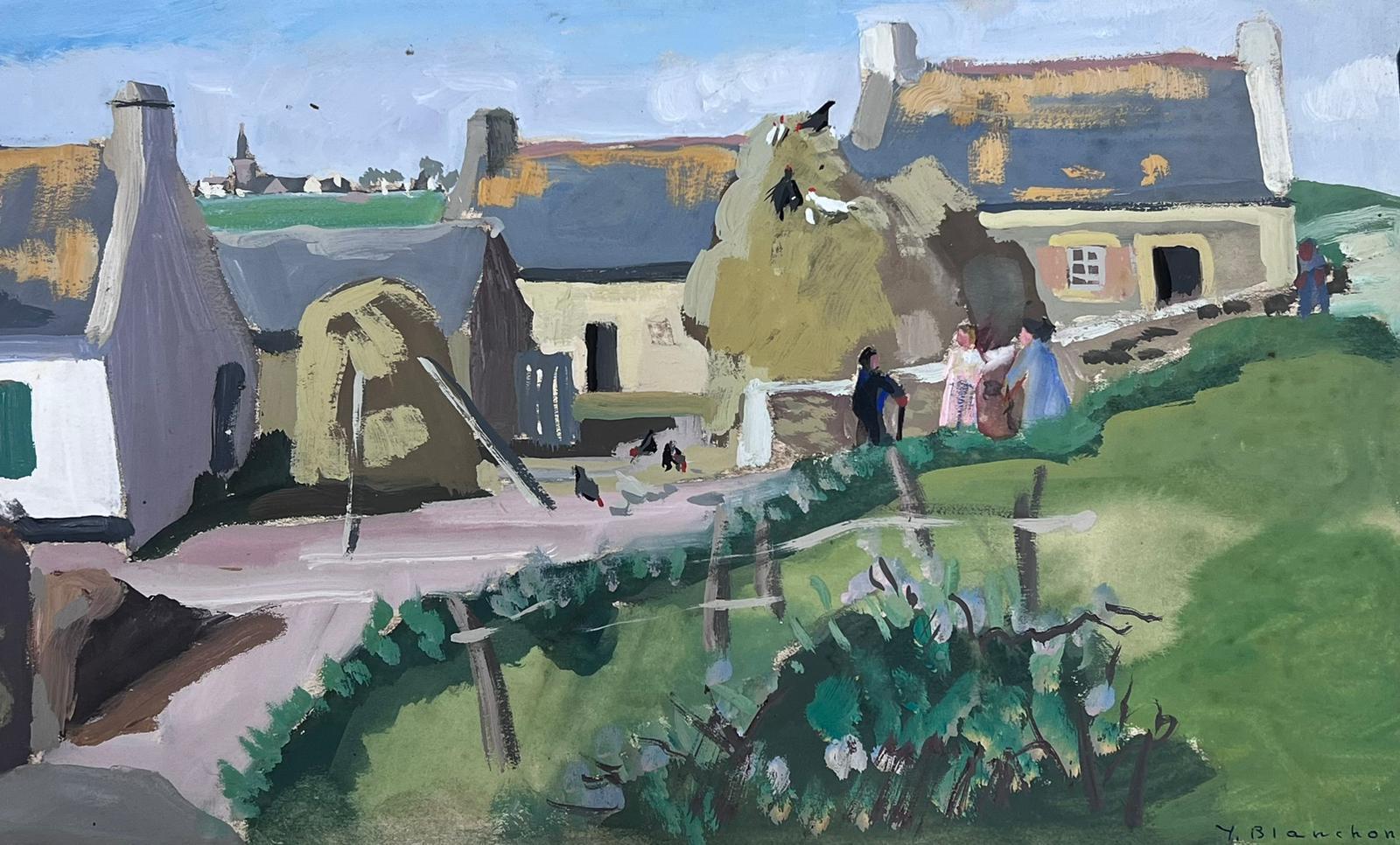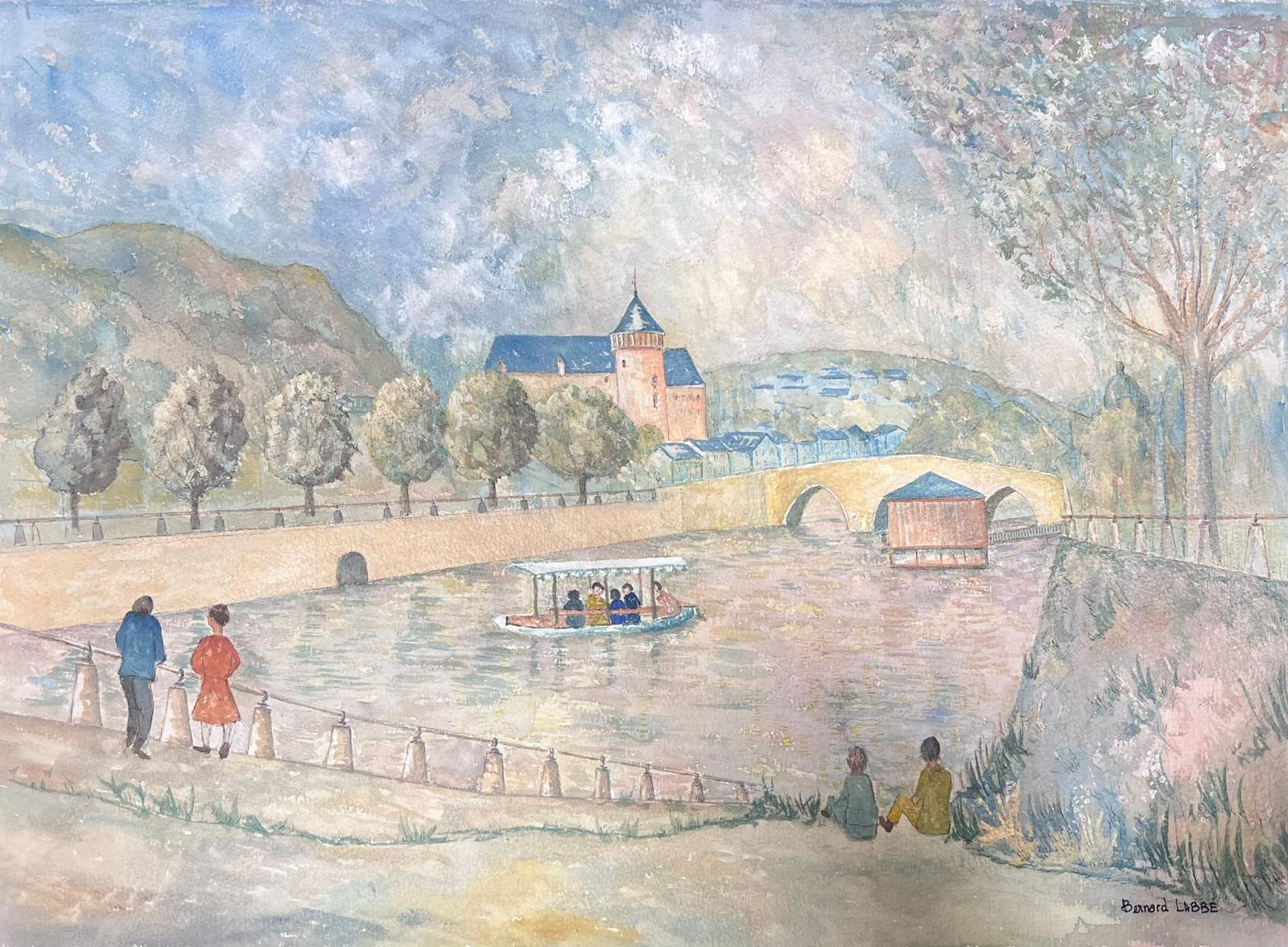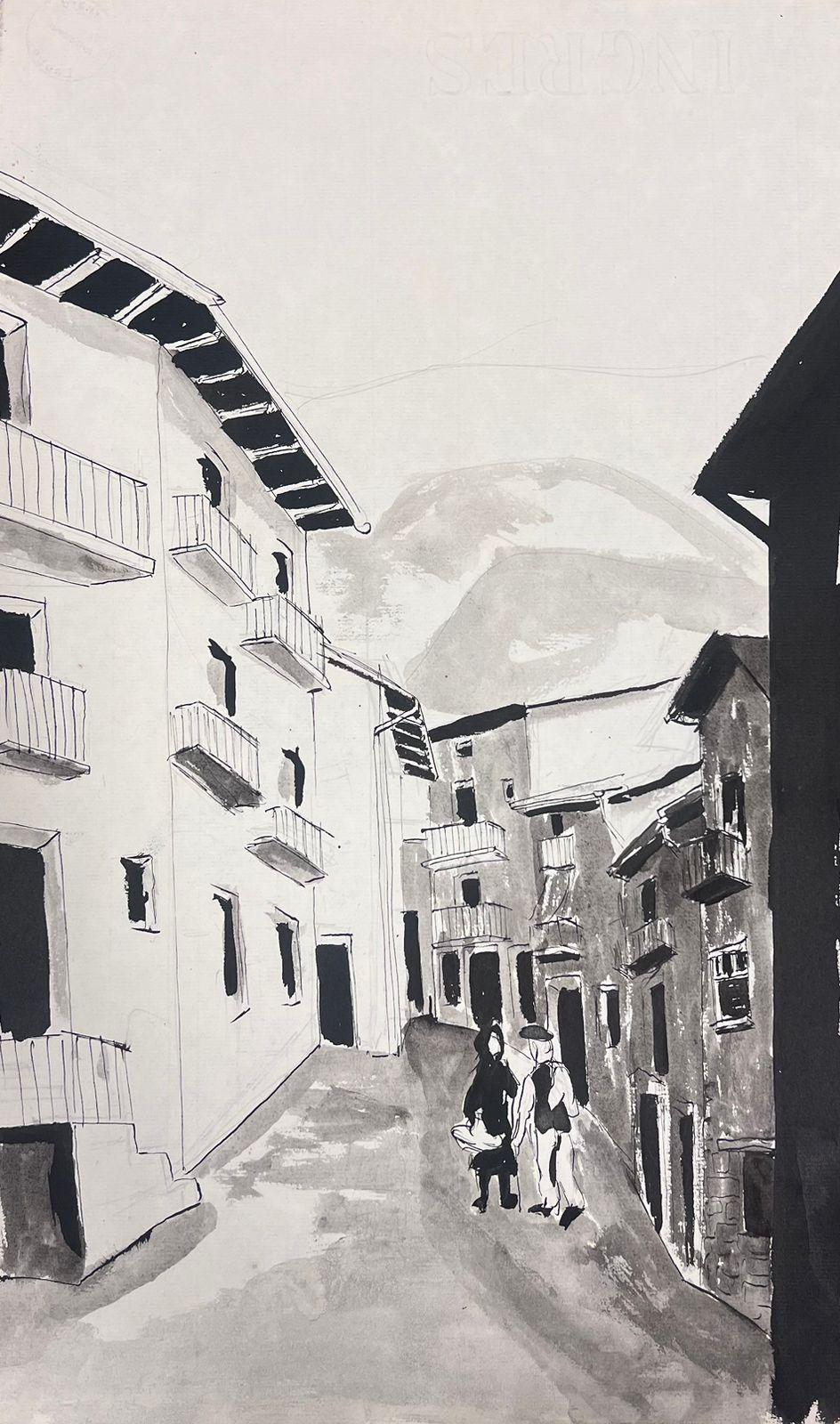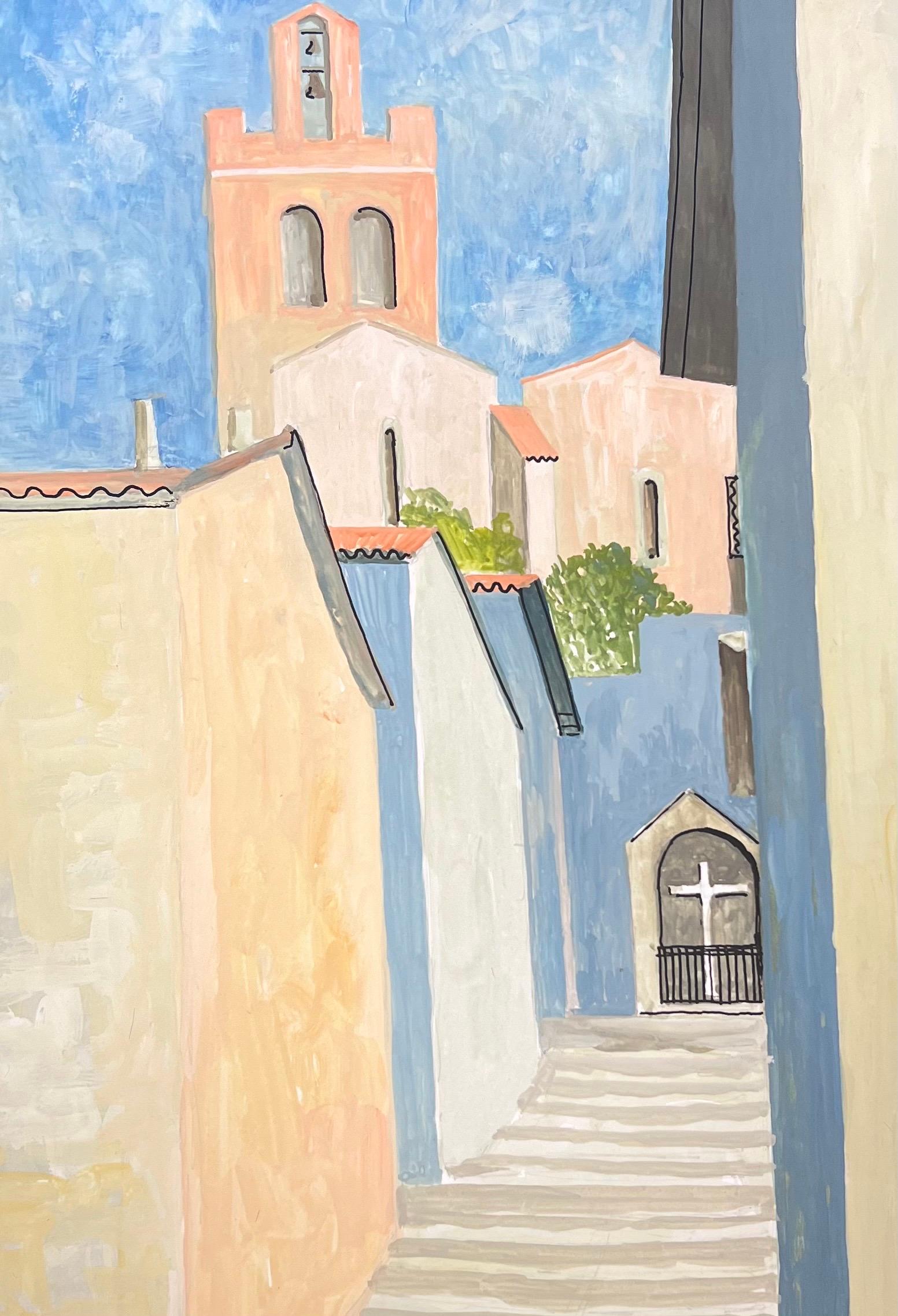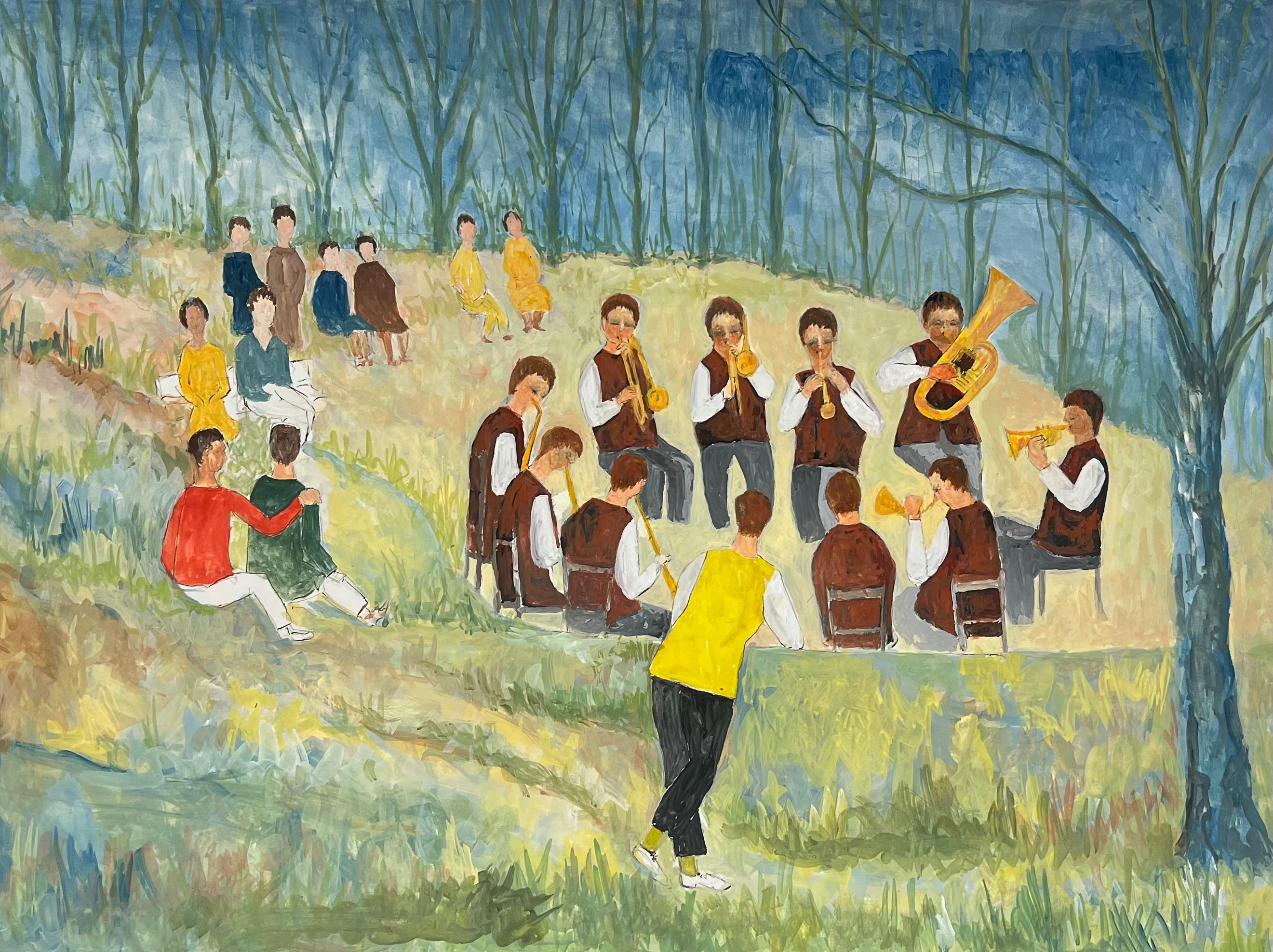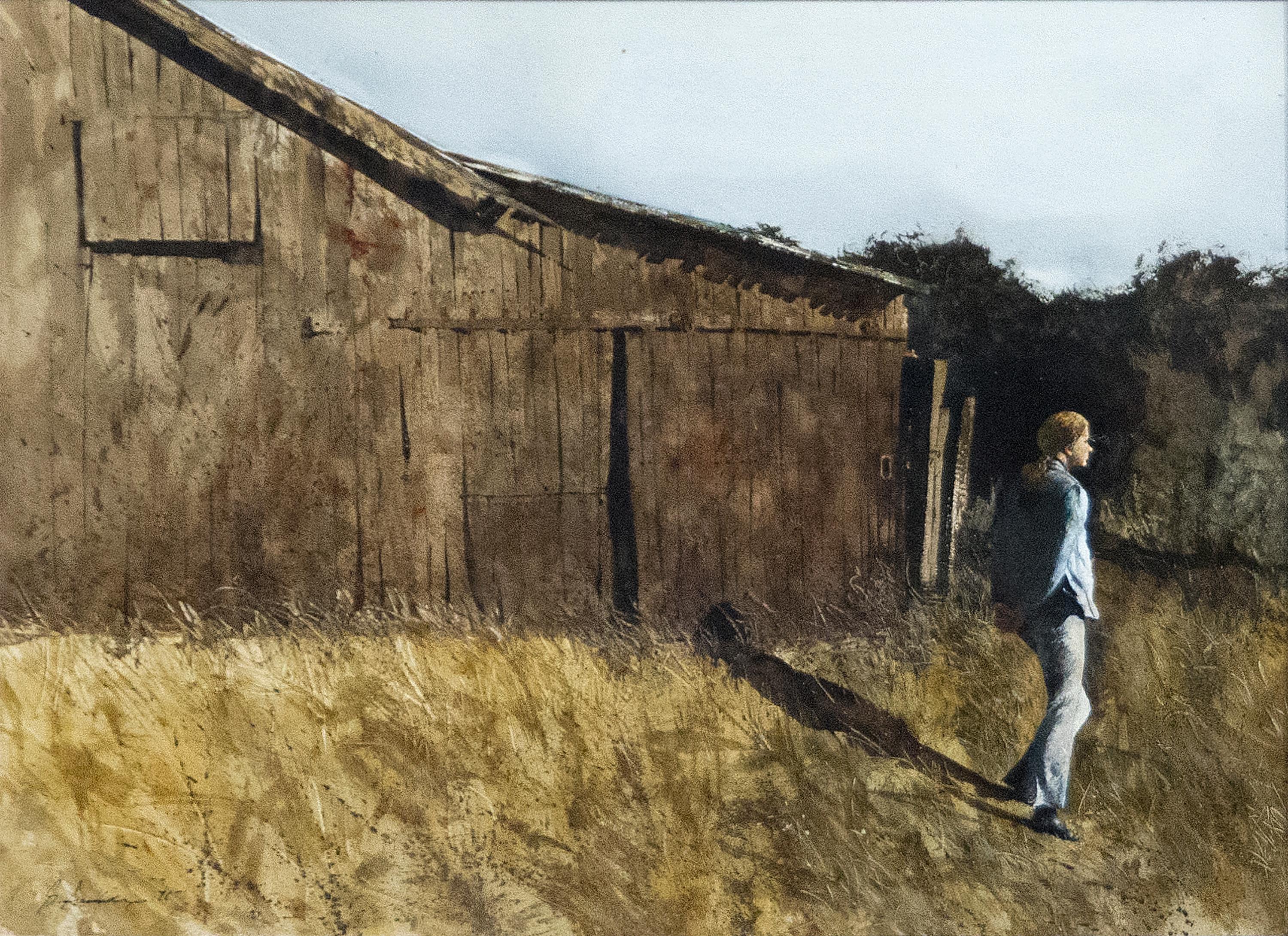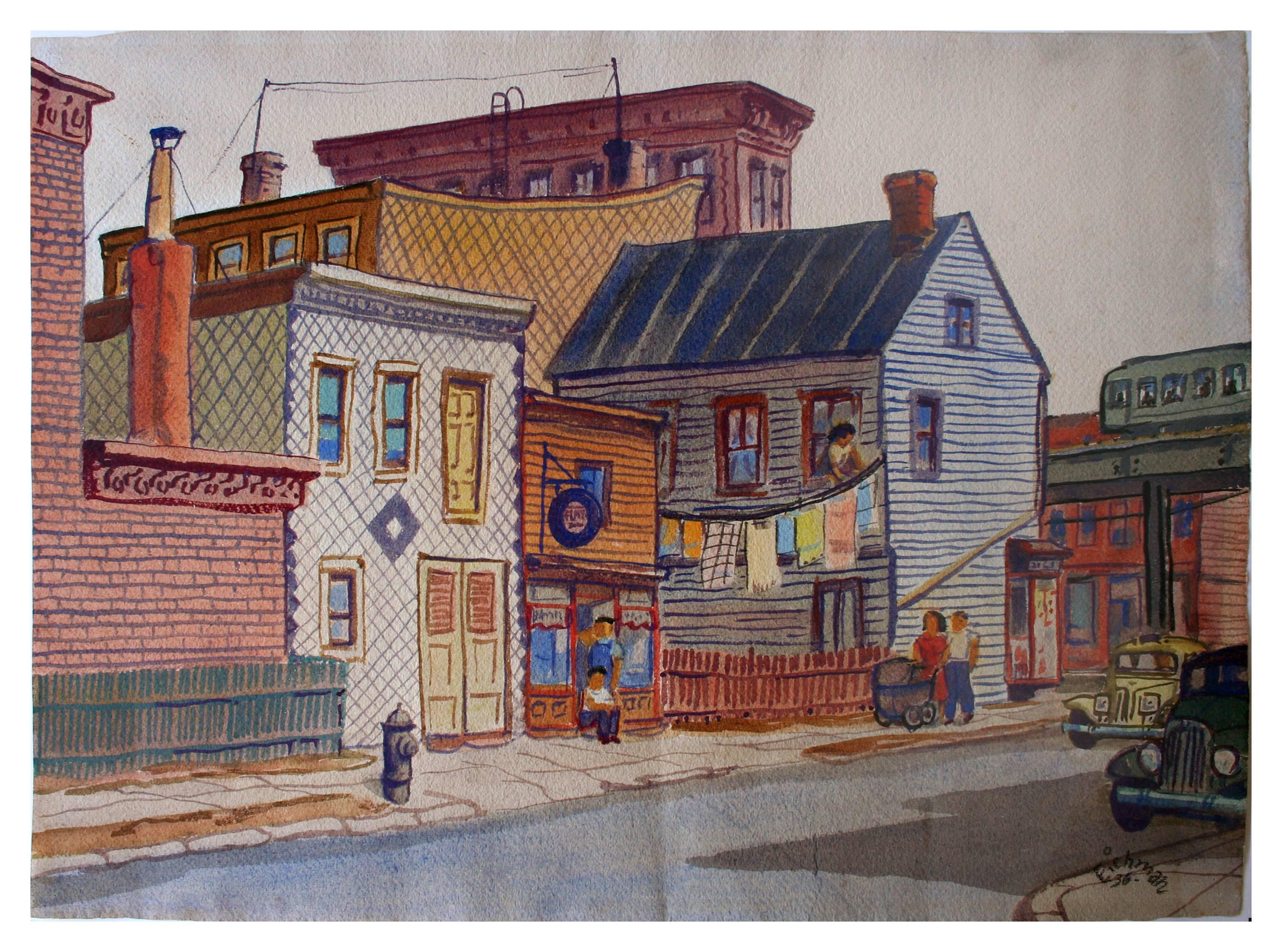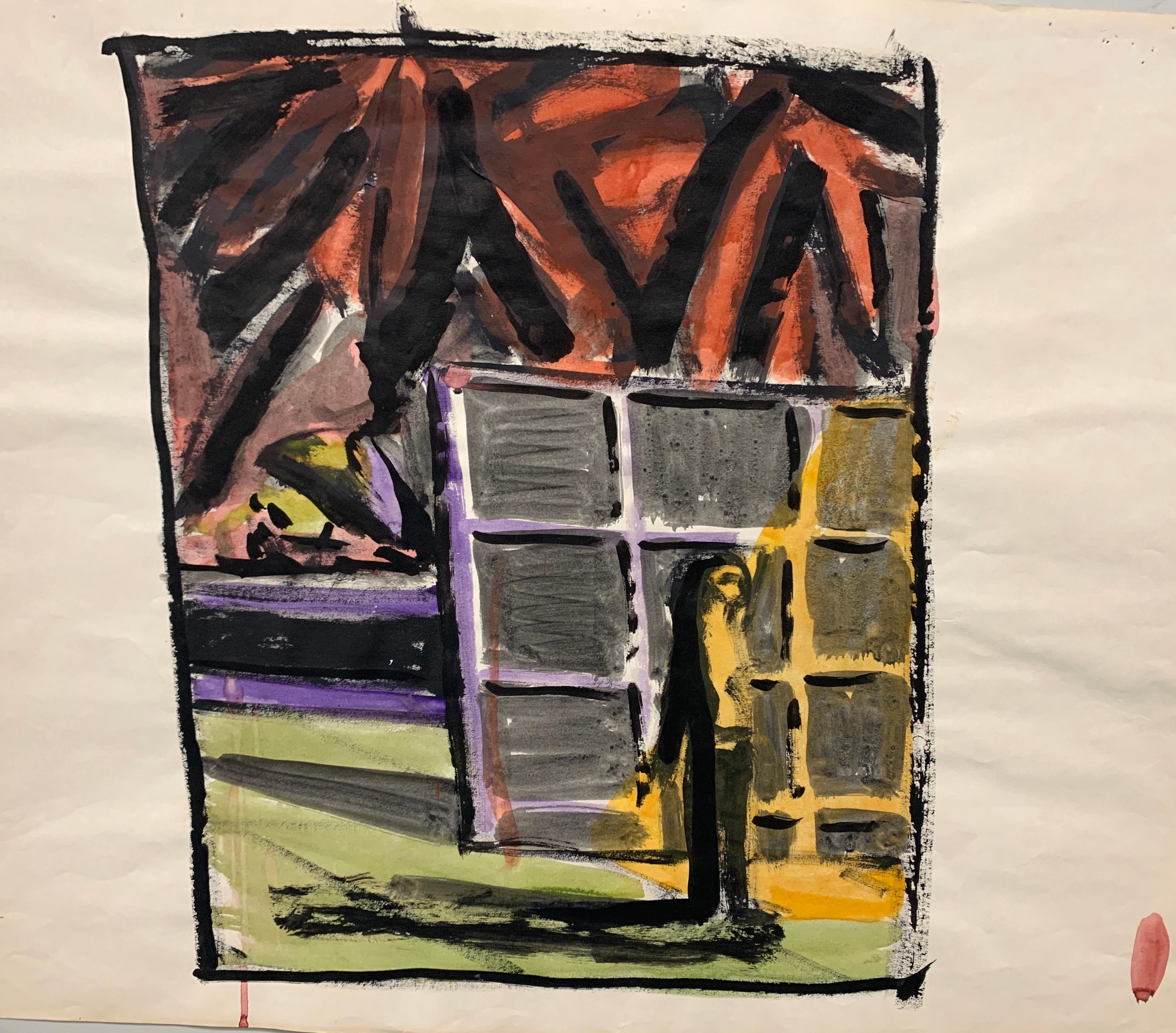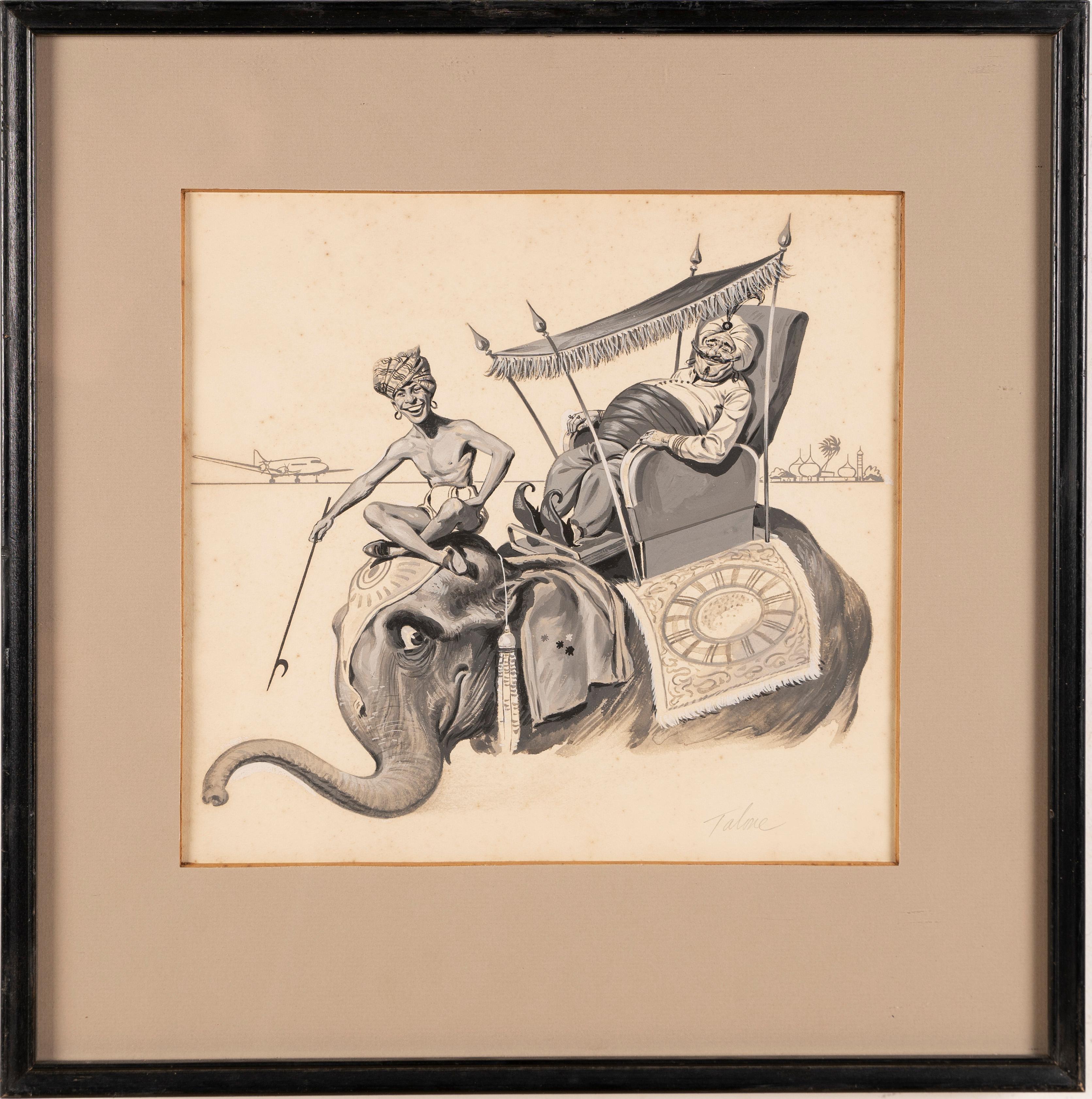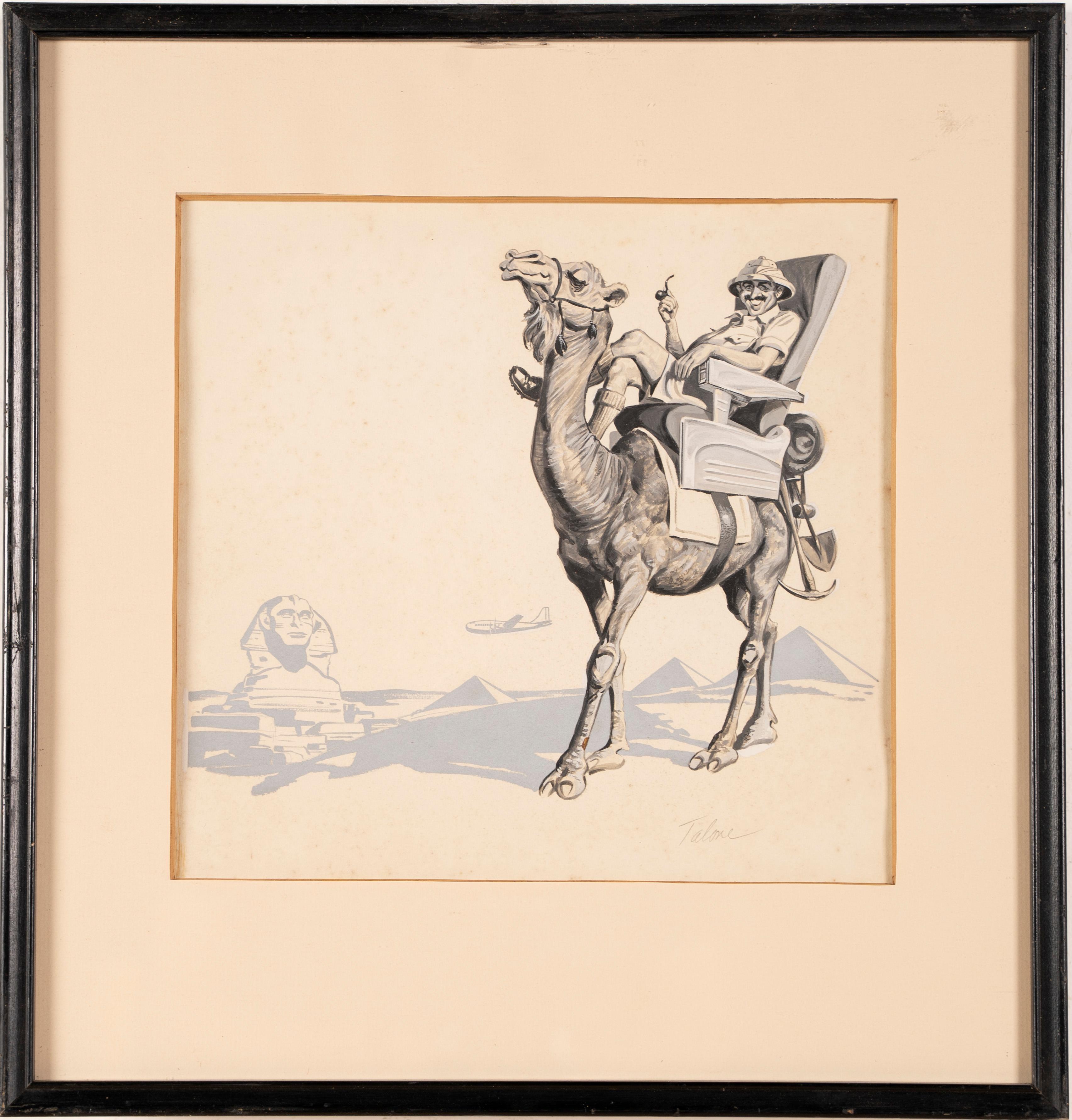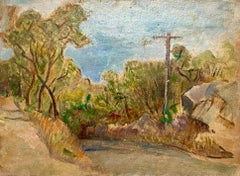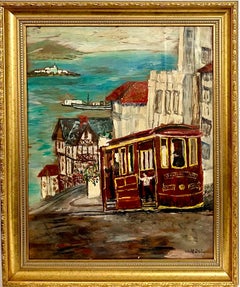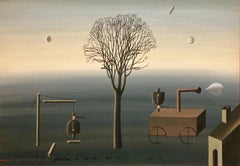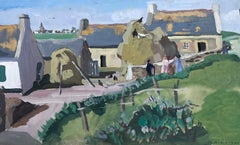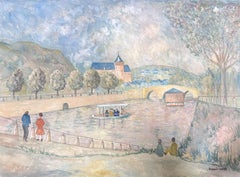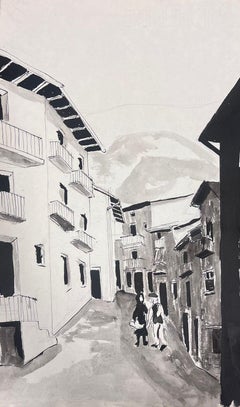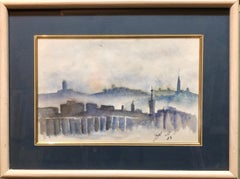
Israeli Modernist Watercolor Landscape Signed in Hebrew
View Similar Items
Want more images or videos?
Request additional images or videos from the seller
1 of 7
UnknownIsraeli Modernist Watercolor Landscape Signed in Hebrew1987
1987
About the Item
- Creation Year:1987
- Dimensions:Height: 14 in (35.56 cm)Width: 18.25 in (46.36 cm)
- Medium:
- Movement & Style:
- Period:
- Condition:signature is illegible. piece has minor wear, under glass, as received by artist, frame has minor wear.
- Gallery Location:Surfside, FL
- Reference Number:Seller: 2251stDibs: LU38213324492
About the Seller
4.9
Platinum Seller
Premium sellers with a 4.7+ rating and 24-hour response times
Established in 1995
1stDibs seller since 2014
1,756 sales on 1stDibs
Typical response time: 1 hour
Authenticity Guarantee
In the unlikely event there’s an issue with an item’s authenticity, contact us within 1 year for a full refund. DetailsMoney-Back Guarantee
If your item is not as described, is damaged in transit, or does not arrive, contact us within 7 days for a full refund. Details24-Hour Cancellation
You have a 24-hour grace period in which to reconsider your purchase, with no questions asked.Vetted Professional Sellers
Our world-class sellers must adhere to strict standards for service and quality, maintaining the integrity of our listings.Price-Match Guarantee
If you find that a seller listed the same item for a lower price elsewhere, we’ll match it.Trusted Global Delivery
Our best-in-class carrier network provides specialized shipping options worldwide, including custom delivery.More From This Seller
View AllSimka Simkhovitch WPA Artist Oil Painting Gouache American Modernist Powerline
By Simka Simkhovitch
Located in Surfside, FL
Simka Simkhovitch (Russian/American 1893 - 1949)
This came with a small grouping from the artist's family, some were hand signed some were not.
These were studies for larger paintings.
Simka Simkhovitch (Симха Файбусович Симхович) (aka Simka Faibusovich Simkhovich) (Novozybkov, Russia May 21, 1885 O.S./June 2, 1885 N.S.—Greenwich, Connecticut February 25, 1949) was a Ukrainian-Russian Jewish artist and immigrant to the United States. He painted theater scenery in his early career and then had several showings in galleries in New York City. Winning Works Progress Administration (WPA) commissions in the 1930s, he completed murals for the post offices in Jackson, Mississippi and Beaufort, North Carolina. His works are in the permanent collections of the Dallas Museum of Art, the National Museum of American Art and the Whitney Museum of American Art. Born outside Kyiv (Petrograd Ukraine) into a Jewish family who owned a small department store. During a severe case of measles when he was seven, Simcha Simchovitch sketched the views outside his window and decided to become an artist, over his father's objections. Beginning in 1905, he studied at the Grekov Odessa Art School and upon completion of his studies in 1911 received a recommendation to be admitted to the Imperial Academy of Arts. Though he enrolled to begin classes in architecture, painting, and sculpture at the Imperial Academy, he was dropped from the school roster in December because of the quota on the number of Jewish students and drafted into the army. Simchovitch served as a private in the 175th Infantry Regiment Baturyn [ru] until his demobilization in 1912. Re-enrolling in the Imperial Academy, he audited classes.
Simka Simkhovitch exhibited paintings and sculptures in 1918 as part of an exhibition of Jewish artists and in 1919 placed 1st in the competition "The Great Russian Revolution" with a painting called "Russian Revolution" which was hung in the State Museum of Revolution. In 1922, Simkha Simkhovitch exhibited at the International Book Fair in Florence (Italian: Fiera Internazionale del Libro di Firenze). In 1924, Simkhovitch came to the United States to make illustrations for Soviet textbooks and decided to immigrate instead. Initially he supported himself by doing commercial art and a few portrait commissions. In 1927, he was hired to paint a screen for a scene in the play "The Command to Love" by Fritz Gottwald and Rudolph Lothar which was playing at the Longacre Theatre on Broadway. Art dealers began clamoring for the screen and Simkhovitch began a career as a screen painter for the theater. Catching the attention of the screenwriter, Ernest Pascal, he worked as an illustrator for Pascal, who then introduced him to gallery owner, Marie Sterner. Simkhovitch's works appeared at the Marie Sterner Gallery beginning with a 1927 exhibit and were repeated the following year. Simkhovitch had an exhibit in 1929 at Sterner's on circus paintings. In 1931, he held a showing of works at the Helen Hackett Gallery, in New York City and later that same year he was one of the featured artists of a special exhibit in San Francisco at the California Palace of the Legion of Honor in Lincoln Park. The exhibit was coordinated by Marie Sterner and included four watercolors, including one titled "Nudes". He is of the generation of Russian Soviet artists such as Isaac Pailes, Serge Charchoune, Marc Chagall, Chana Orloff, Isaac Ilyich Levitan, and Ossip Zadkine.
In 1936, Simkhovitch was selected to complete the mural for the WPA Post office project in Jackson, Mississippi. The mural was hung in the post office and courthouse in 1938 depicted a plantation theme. Painted on the wall behind the judge’s bench, “Pursuits of Life in Mississippi”, a depiction of black workers engaged in manual labor amid scenes of white professionals and socialites, was eventually covered over in later years during renovations due to its stereotypical African American imagery. Simka painted what he thought was typical of Jackson. His impression of pre-civil rights Mississippi was evidently Greek Revival column houses, weeping willow trees, working class families, and the oppression of African Americans. He painted African American men picking cotton, while a white man took account of the harvest and a white judge advised a white family, calling it Pursuits of Life in Mississippi.
Though clearly endorsed by the government and initially generally well-received, the mural soon raised concerns with locals as the climate toward racial segregation began to change. The main concern was whether depictions that show African Americans in subjugated societal roles should be featured in a courtroom. The following year, his painting "Holiday" won praise at an exhibition in Lincoln, Nebraska. In 1940, Simkhovitch's second WPA post office project was completed when four murals, "The Cape Lookout Lighthouse and the Orville W. Mail Boat", "The Wreck of the Crissie Wright", "Sand Ponies" and "Canada Geese" were installed in Beaufort, North Carolina. The works were commissioned in 1938 and did not generate the controversy that the Jackson mural had. The main mural is "The Wreck of the Crissie Wright" and depicts a shipwreck which had occurred in Beaufort in 1866. "The Cape Lookout Lighthouse and the Orville W. Mail Boat" depicted the lighthouse built in 1859 and the mail boat that was running mail during the time which Simkhovitch was there. The boat ran mail for the area until 1957. "Sand Ponies" shows the wild horses common to the North Carolina barrier islands and "Canada Geese" showed the importance of hunting and fishing in the area. All four murals were restored in the 1990s by Elisabeth Speight, daughter of two other WPA muralists, Francis Speight...
Category
1930s American Modern Landscape Paintings
Materials
Oil, Board, Gouache
San Francisco Cable Car WPA Artist Adolf Dehn Modernist Art Gouache Oil Painting
By Adolf Dehn
Located in Surfside, FL
ADOLF ARTHUR DEHN (American, 1895-1969)
San Francisco Bay Area street scene, with Trolley, Streetcar, Cable Car with bay and Alcatraz Island in background.
Hand signed LRC.
Sight 19" x 15", overall 23" x 19".
Adolf Dehn (November 22, 1895 – May 19, 1968) was an American artist known mainly as a lithographer. Throughout his artistic career, he participated in and helped define some important movements in American art, including regionalism, social realism, and caricature. A two-time recipient of the Guggenheim Fellowship, he was known for both his technical skills and his high-spirited, droll depictions of human foibles.
Adolph Dehn was born in 1895 in Waterville, Minnesota. He began creating artwork at the age of six, and by the time of his death had created nearly 650 images.
Dehn went to the Minneapolis School of Art (known today as the Minneapolis College of Art and Design), where he met and became a close friend of Wanda Gag. In 1917 he and Gág were two of only a dozen students in the country to earn a scholarship to the Art Students League of New York. He was drafted to serve in World War I in 1918, but declared himself a conscientious objector and spent four months in a guardhouse detention camp in Spartanburg, SC and then worked for eight months as a painting teacher at an arm rehabilitation hospital in Asheville, NC. Later, Dehn returned to the Art Students League for another year of study and created his first lithograph, The Harvest.
In 1921 Dehn's lithographs were featured in his first exhibition at Weyhe Gallery in New York City. From 1920 to 1921 in Manhattan, he was connected to New York's politically left-leaning activists. In 1921, he went to Europe. In Paris and Vienna he belonged to a group of expatriate intellectuals and artists, including Andrée Ruellan, Gertrude Stein, and ee cummings...
Category
1930s American Modern Figurative Paintings
Materials
Gouache, Oil
Latvian Israeli Surreal Gouache Illustration Art Painting Tel Aviv
By Maris Bishofs
Located in Surfside, FL
Maris Bishofs was born in 1939 in Rujiena, Latvia. In 1965 he became the first artist to graduate from the Latvian Art Academy with an interior design diploma. In 1972 he emigrated t...
Category
1970s Surrealist Figurative Paintings
Materials
Gouache
Austrian Magic Realist Oil Painting Vibrant Village Landscape Scene Franz Coufal
Located in Surfside, FL
Framed 24.5 x 28.5 image 19.5 x 23 inches.
Franz Anton Coufal (Austrian, 1927 - 1999) Painter and sculptor known for figure painting, bronze sculpture, genre paintings and as a graphic artist.
After completing an apprenticeship as a locksmith, Franz Anton Coufal attended the Graphic Education and Research Institute in Vienna from 1947 to 1949 as a student of André Roder and from 1949 to 1953 took lessons from Ignaz Schönbrunner. From 1953 to 1959 he finally studied with Fritz Wotruba at the Academy of Fine Arts (diploma and master school award 1959).
Coufal then went on study trips to Germany and Italy and then settled in Vienna as a sculptor and graphic artist. His work bears the influence of Austrian Magic Realism and the artists Friedensreich Hundertwasser, Arik Erich Brauer and Ernst Fuchs. THis work also has Expressionist elements to it. He organized exhibitions in Vienna (from 1955), Paris (1962, 1970) and Brussels (1964) as well as in other Austrian cities. His most important works include the honorary grave for Leopold Figl in the central cemetery (1966). In 1979 he provided the design for the face of the silver 100 schilling coin "Festival and Congress House Bregenz", in 1980 he created the Lehár monument for the city park, and in 1987 he received the special prize in the "Danube Region Vienna" competition.
A select list of his sculptures in public spaces
"Standing youth" (19, Hameaustraße - Celtesgasse, urban residential complex; 1960)
"Reclining youth" (22, Kagran [Meißnergasse - Maißauer Gasse - Anton-Sattler-Gasse]; artificial stone, 1962)
"Flammender Turm" (16, Thaliastraße 159; marble)
Cubist marble sculpture (11, Molitorgasse at 15)
Drinking fountain (20, Adalbert-Stifter-Straße primary school; 1968)
Figldenkmal (1, Minoritenplatz, 1973)
Coufal created some of his later works for the "Harmonie" rest home for the blind in Unterdambach near Neulengbach (memorial for the 144 blind people who perished in concentration camps, unveiled in 2000; stone sculpture "Monument to Humanity" on the terrace; rose-thorn cross and tabernacle for the in-house Odilien- Chapel; bronze portrait sculpture by Robert Vogel in the entrance hall, unveiled July 3, 1994).
Bibliography
Rudolf Schmidt: Austrian artist lexicon. From the beginning to the present. Vienna: Tusch 1974-1980
Who's Who in the world. Volume 2: 1974-1975. New Providence, NJ: Marquis Who's Who 1974
Who's who in the world. Volume 3: 1976-1977. New Providence, NJ: Marquis Who's Who 1976
Who is Who in Austria with South Tyrol part (Hübner's "Blue Who is Who"). Zug: Who is who, Verlag für Personalenzyklopädien 12 1995
Otto Breicha: Franz Anton Coufal In: Franz Anton Coufal. Österreichische Staatsdruckerei, December 9-22, 1964. Vienna: Staatsdruckerei 1964
The press, July 30, 1963
Of the generation of Viennese artists Alois Mosbacher, Josef Mikl, Oswald Oberhuber, Christian Ludwig Attersee, Peter Sengl, Max Weiler, Franz Ringel, Gunter Brus, Hubert Schmalix, Wilhelm Kaufmann, Paul Flora, Oscar Larsen, Hans Staudacher, Siegfried Anzinger, Ernst Huber...
Category
20th Century Modern Landscape Paintings
Materials
Canvas, Oil
King David, Jerusalem (after Marc Chagall) Oil Painting Israeli Judaica Art
By Zammy Steynovitz
Located in Surfside, FL
Framed 41.5 x 29.5 image 35.5 x 23.5
This large painting depicts a man and woman, Adam and Eve, interlocked and embracing one another. The woman holds an enticing apple as they are thrusted from the Garden of Eden.
This is an original painting. Zamy Steynovitz was born in Liegnitz Poland, in 1951. He immigrated to Israel in 1957. The aspiration to be a painter stems from his childhood and before leaving Poland, he won the first prize in an art competition for children.
Zamy was formally educated at the Art School in Tel-Aviv and at the Royal Academy of London. Upon completing his studies, Zamy earnestly pursued his career and establish his place in the art world by displaying his work in one man exhibits and arts fairs around the world.
His art displays chromatic and thematic richness and his choice of subjects has been strongly influenced by Jewish tradition, his Eastern European Jewish heritage and folklore. Zamy’s popular themes include Paris cafes, still-life, flowers, circuses and landscapes. Circus with acrobats and Harlequin. In the early stages of his career, he was partial to rich pastels and light brush strokes.
In the early 1980s, Zamy visited South America, where the new surroundings enhanced his work with local brightness and color. His art gained chromatic power and his palette became richer in tones as the textures became thicker and the background darker and more colorful. These changes coupled with his thematic persistence allowed him to develop into a sensitive and mature artist.
Zamy expresses a universal humanistic vision in his creations: man’s connection to his heritage and physical surroundings, two imperative aspects of our lives that should be heralded during these estranged technological times.
As a result of his devotion to world peace, Zamy is known in the circles of the Nobel Institute for Peace in Norway. He is acquainted with many Nobel Prize winners including Anwar Sadat, Menachem Begin, the Dalai Lama, Itzhak Rabin, Shimon Peres, Elie Wiesel, Desmond Tutu and Oscar Arias, the ex-President of Costa Rica, along with many other politicians and artists. Zamy tragically passed away in September 2000.
Exhibitions One Man Show
1970 - Museum - Ramat - Gan
1973 - Brussels - Gallery L'Angle Aigu
1974 - London - International Gallery
1974 - Paris - Grand Palais Gallery
1975 - Milan - Brera Gallery
1976 - N.Y. Valentino Gallery - N.Y. Hilton
1977 - N.Y. Valentino Gallery - N.Y. Hilton
1978 - Basel - Actual Gallery
1978 - Geneve - Bohren Gallery
1978 - Oslo - Nobel Peace Prize Exhibit
1979 - London - Hamilton Gallery
1979 - N.Y. - Art Israel Kalt - Waldinger Gallery
1979 - N.Y. - Canty Art Gallery
1979 - Amsterdam - Schipper Gallery
1979 - Washington - International Art Fair
1980 - Cleveland -Jewish Museum
1980 - Tel-Aviv - Habima National Art Fair
1981 - Abraham - Goodman House N.Y.
1981 - San Lucas Galley - Bogota
1982 - Pedro Gerson Gallery - Mexico City
1983 - Simon Bolivar...
Category
20th Century Modern Figurative Paintings
Materials
Canvas, Oil
1927 Oil Painting Eiffel Tower Paris American Modernist Wpa Artist Morris Kantor
By Morris Kantor
Located in Surfside, FL
Morris Kantor New York (1896 - 1974)
Paris from the Ile St. Louis, 1927 (view of Eiffel Tower)
Oil painting on canvas
Hand Signed lower left.
Provenance: Hirshhorn Museum and Sculpture Garden, Smithsonian Institution ( bears label verso)
Size: 20 3/4"H x 28 1/8"W (sight), 28.75 "H x 36"W (framed)
Morris Kantor (Belarusian: Морыс Кантор) (1896-1974) was a Russian Empire-born American painter based in the New York City area.
Born in Minsk on April 15, 1896, Kantor was brought to the United States in 1906 at age 10, in order to join his father who had previously relocated to the states. He made his home in West Nyack, New York for much of his life, and died there in 1974. He produced a prolific and diverse body of work, much of it in the form of paintings, which is distinguished by its stylistic variety over his long career. Perhaps his most widely recognized work is the iconic painting "Baseball At Night", which depicts an early night baseball game played under artificial electric light. Although he is best known for his paintings executed in a realistic manner, over the course of his life he also spent time working in styles such as Cubism and Futurism, and produced a number of abstract or non-figural works. A famous cubist, Futurist, painting of his "Orchestra" brought over 500,000$ at Christie's auction house in 2018
Kantor found employment in the Garment District upon his arrival in New York City, and was not able to begin formal art studies until 1916, when he began courses at the now-defunct Independent School of Art. He studied landscape painting with Homer Boss (1882-1956). In 1928, after returning to New York City from a year in Paris, Kantor developed a style in which he combined Realism with Fantasy, often taking the streets of New York as his subject matter. He did some moody Surrealist Nude paintings and fantasy scenes. In the 1940's he turned towards figural studies. Later in his career, Kantor himself was an instructor at the Cooper Union and also at the Art Students League of New York in the 1940s, and taught many pupils who later became famous artists in their own right, such as Knox Martin, Robert Rauschenberg, Sigmund Abeles and Susan Weil...
Category
1920s American Modern Landscape Paintings
Materials
Canvas, Oil
You May Also Like
Petit Rhône, Gouache varnish on cardboard
Located in PARIS, FR
Pierre Charbonnier (1897-1978)
Small Rhone
Gouache varnish on cardboard
Signed "P. Charbonnier" and titled "Petit Rhône" lower right
15 x 20,5 inch
Frame : 50 x 70 cm
Born in 1897 i...
Category
Mid-20th Century Modern Landscape Paintings
Materials
Gouache
1950's French Impressionist Painting Ladies Gossiping On The Town Bridge
Located in Cirencester, Gloucestershire
Ladies Gossiping
by Y. Blanchon, French 1950's Impressionist artist
signed gouache on artist paper stuck on paper, unframed
size: 12.5 x 19.5 inches
provenance: from a large private ...
Category
Mid-20th Century Modern Landscape Paintings
Materials
Gouache
1950's Modernist Painting Figures Along The French River Bank
By Bernard Labbe
Located in Cirencester, Gloucestershire
French Landscape
by Bernard Labbe (French mid 20th century)
signed original gouache on artist paper
size: 15 x 21 inches
condition: very good and ready to be enjoyed
provenance: the...
Category
Mid-20th Century Modern Landscape Paintings
Materials
Gouache
$868 Sale Price
20% Off
1950's Modernist Painting Figures Walking Through Black and White French Street
By Bernard Labbe
Located in Cirencester, Gloucestershire
French Landscape
by Bernard Labbe (French mid 20th century)
original watercolour on artist paper
size: 19 x 12 inches
condition: very good and ready to be enjoyed
provenance: the ar...
Category
Mid-20th Century Modern Figurative Paintings
Materials
Watercolor
20th Century Modernist Painting Steps Leading To Church
By Bernard Labbe
Located in Cirencester, Gloucestershire
French Landscape
by Bernard Labbe (French mid 20th century)
original gouache on artist paper
size: 20.5 x 10 inches
condition: very good and ready to be enjoyed
provenance: the art...
Category
Mid-20th Century Modern Landscape Paintings
Materials
Gouache
$705 Sale Price
20% Off
1950's Open Air Jazz Concert in The Summer Forest French Landscape
By Bernard Labbe
Located in Cirencester, Gloucestershire
Forest Jazz Band
by Bernard Labbe (French mid 20th century)
original gouache on artist paper
size: 20 x 25.5 inches
condition: very good and ready to be enjoyed
Description: This li...
Category
Mid-20th Century Modern Figurative Paintings
Materials
Gouache
$726 Sale Price
20% Off
